Hospitalisations for family and domestic violence
Some people who experience family and domestic violence require care from a health professional, and in some cases are admitted to hospital. The number of hospitalisations for injuries related to family and domestic violence provides an indication of the demand for these services. However, these data do not include presentations to emergency departments and will relate to more severe (and mostly physical) experiences of family and domestic violence. In addition, some people who are hospitalised may choose not to disclose their experience of family and domestic violence, or the information may not be fully recorded so their hospitalisations may not be counted here. Data are drawn from the AIHW National Hospital Morbidity Database.
The visualisation below allows users to explore the rate of family and domestic violence hospitalisations, by sex over time. For each year examined, the age-standardised rate of family and domestic violence hospitalisations was over two times as high for females compared with males. Between 2017–18 and 2020–21 the age-standardised rate for females increased by 9.6% and the rate for males remained relatively stable. Changes in hospitalisation rates may be due to changes in disclosure rates, changes in identification of family and domestic violence by health professionals, and/or changes in the number of family and domestic violence events requiring hospitalisation.
Family and domestic violence hospitalisations, by sex, 2009–10 to 2020–21
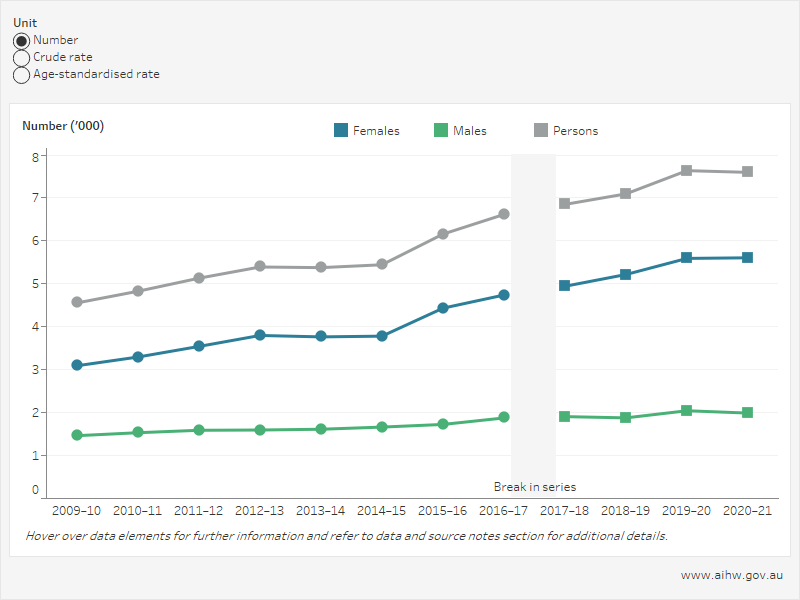
The visualisation below allows users to explore the rate of family and domestic violence hospitalisations by relationship to perpetrator and sex, over time. Rates of hospitalisation where the perpetrator was a spouse or domestic partner were consistently around 6 times higher for females aged 15 years and over than for males. Hospitalisation patterns by sex were mixed for other perpetrator types (parent or other family member).
Family and domestic violence hospitalisations, by relationship to perpetrator, 2017–18 to 2020–21
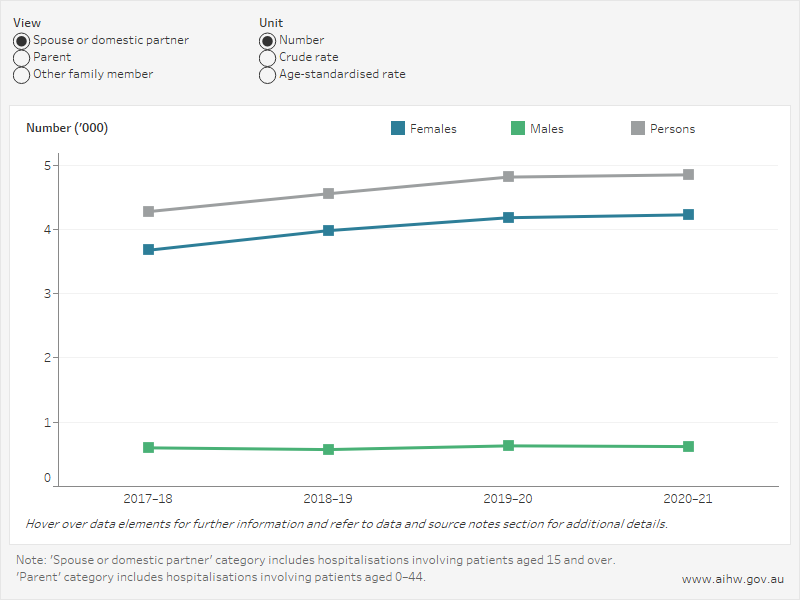
The visualisation below allows users to explore the rate of Indigenous family and domestic violence hospitalisations by relationship to perpetrator and sex, across age groups. It shows that between 2017–18 and 2020–21, age-standardised rates for Indigenous females were between 2.7 and 3.1 times as high as for Indigenous males.
Indigenous family and domestic violence hospitalisations, by sex, 2017 –18 to 2020–21
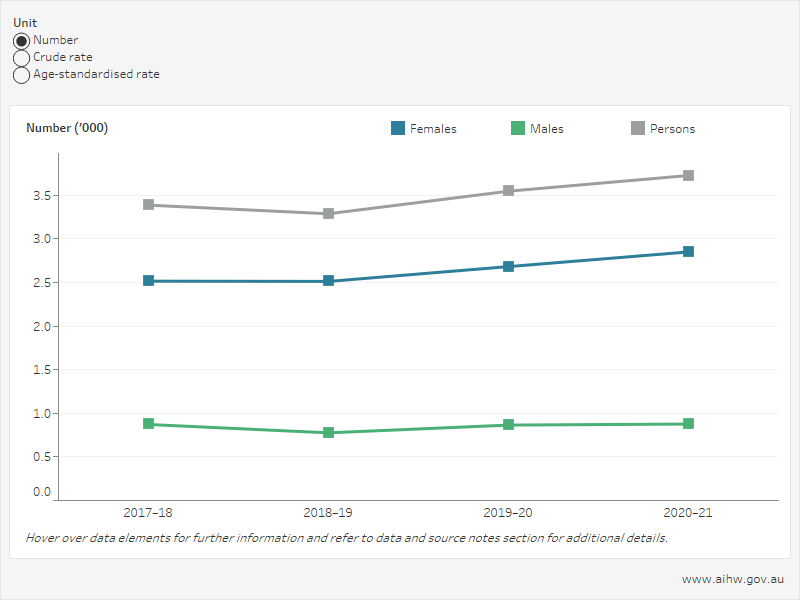
The visualisation below allows users to explore the rate of family and domestic violence hospitalisations by relationship to perpetrator and sex, across age groups. In 2020–21, the number and rate of family and domestic hospitalisation were greater for females than males across all age groups. For females, the rate was highest for those aged 25–34, while for males the rate was highest for those aged 35–44.
Of hospitalisations due to intentional injury from a spouse or domestic partner, 87% involved a female, with rates for females consistently higher than males for all age groups. Patterns by sex and age were relatively similar for hospitalisation involving injuries by a parent or other family member.
Family and domestic violence hospitalisations by relationship to perpetrator, 2019–20 and 2020–21
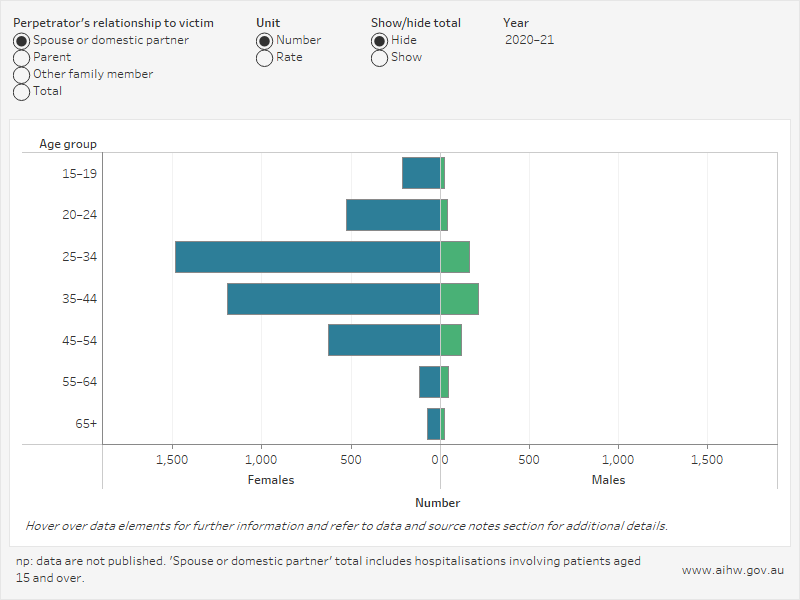
Population groups
This information can be used to inform the development of more targeted programs and services for select population groups.
The visualisation below allows users to explore the rate of family and domestic violence hospitalisations, by various population groups. In 2020–21, age-standardised rates of family and domestic violence hospitalisations:
- were 31 times as high for Indigenous Australians than non-Indigenous Australians, with a larger difference for females (33 times higher than other Australian females) than males (27 times higher than other Australian males)
- were highest for those living in the Northern Territory
- increased with remoteness
- were highest for those in the most disadvantaged socioeconomic areas compared to all other socioeconomic areas.
Family and domestic violence hospitalisations, for select population groups, 2019–20 and 2020–21
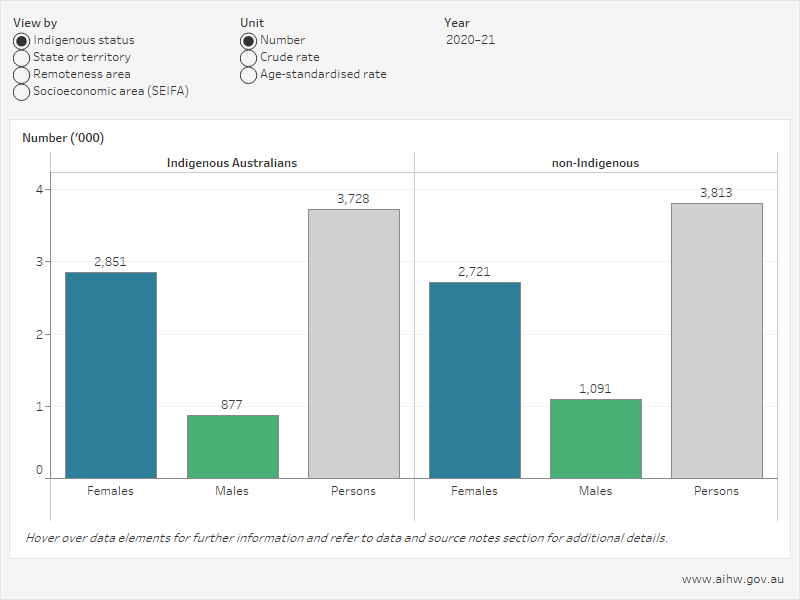
Notes
- A hospitalisation is an episode of admitted patient care where:
- mode of admission has any value except the one indicating that a transfer from another acute-care hospital has occurred
- the diagnosis field does not contain the International Classification of Diseases-10-Australian Modification (ICD-10-AM) code Z50 (care involving the use of rehabilitation procedure)
- type of care has any value except the one indicating newborn with unqualified days.
- Family and domestic violence hospitalisations have:
- an injury principal diagnosis in the ICD-10-AM code range S00-T75, T79.
- a first recorded External causes of morbidity and mortality ICD-10-AM code in the range X85 - Y09 (Assault), and a perpetrator coded as Spouse or domestic partner, Parent, or Other family member (5th character codes of 0,1,2 respectively). An 'external cause' is the term used in disease classification to refer to an event or circumstance in a person's external environment that is regarded as a cause of injury or poisoning.
- A change in New South Wales’ emergency department admission policy resulted in a significant decrease (3.7%) in public hospital admissions between 2016-17 and 2017-18. As this decrease disproportionately affected hospitalisations for injury and poisoning, and the size of the contribution of NSW data to the national total, data from 2017-18 onwards should not be compared with those of previous years (break in series).
-
Interpretation of changes over time should take into account changes in the proportion of all hospitalisations for assault where perpetrator information was not specified: from 54% in 2009-10 to 33% in 2019-20.
-
Age is age at admission.
- Totals include records where age, remoteness area and/or socioeconomic area were unavailable, therefore the sum of these group counts may not equal the total.
- Data exclude hospitalisations in Western Australia (WA) with a contracted patient status of 'Inter-hospital contracted patient to private sector hospital', to adjust for separations recorded on both sides of contractual care arrangements. Data from 2012-13 onwards has been updated to remove the contracted duplicates. As a result, national counts in these tables will not match previously published data.
- For more information see Methods, Glossary and Data sources.
Sources
AIHW National Hospital Morbidity Database (NHMD)
Hospitalisations for family and domestic violence (70KB XLSX)


